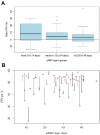Does the age of packed red blood cells, donor sex or sex mismatch affect the sublingual microcirculation in critically ill intensive care unit patients? A secondary interpretation of a retrospective analysis
- PMID: 35665876
- PMCID: PMC9852146
- DOI: 10.1007/s10877-022-00877-3
Does the age of packed red blood cells, donor sex or sex mismatch affect the sublingual microcirculation in critically ill intensive care unit patients? A secondary interpretation of a retrospective analysis
Abstract
In vitro studies have thoroughly documented age-dependent impact of storage lesions in packed red blood cells (pRBC) on erythrocyte oxygen carrying capacity. While studies have examined the effect of pRBC age on patient outcome only few data exist on the microcirculation as their primary site of action. In this secondary analysis we examined the relationship between age of pRBC and changes of microcirculatory flow (MCF) in 54 patients based on data from the Basel Bedside assessment Microcirculation Transfusion Limit study (Ba2MiTraL) on effects of pRBC on sublingual MCF. Mean change from pre- to post-transfusion proportion of perfused vessels (∆PPV) was + 8.8% (IQR - 0.5 to 22.5), 5.5% (IQR 0.1 to 10.1), and + 4.7% (IQR - 2.1 to 6.5) after transfusion of fresh (≤ 14 days old), medium (15 to 34 days old), and old (≥ 35 days old) pRBC, respectively. Values for the microcirculatory flow index (MFI) were + 0.22 (IQR - 0.1 to 0.6), + 0.22 (IQR 0.0 to 0.3), and + 0.06 (IQR - 0.1 to 0.3) for the fresh, medium, and old pRBC age groups, respectively. Lower ∆PPV and transfusion of older blood correlated with a higher Sequential Organ Failure Assessment (SOFA) score of patients upon admission to the intensive care unit (ICU) (p = 0.01). However, regression models showed no overall significant correlation between pRBC age and ∆PPV (p = 0.2). Donor or recipient sex had no influence. We detected no significant effect of pRBC on microcirculation. Patients with a higher SOFA score upon ICU admission might experience a negative effect on the ∆PPV after transfusion of older blood.
Keywords: Capillary blood flow packed red blood cells, age; Oxygen supply; Red blood cell transfusion; Sex mismatch; Storage lesions; Sublingual microcirculation; Transfusion.
© 2022. The Author(s).
Conflict of interest statement
Martin Siegemund, MD has received speaker honoraria from Fresenius Kabi, Switzerland. The other authors declare that there are no competing interests.
Figures



References
Publication types
MeSH terms
LinkOut - more resources
Full Text Sources

